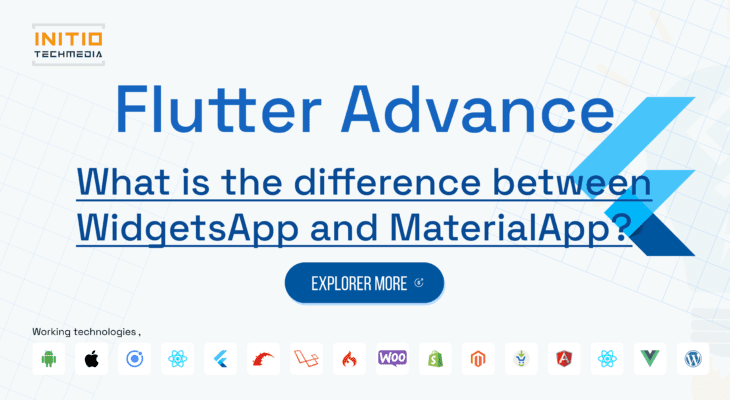Leading Mobile & web Development company which is providing Ready to publish apps & on demands application in Global Bussiness.
- 908, B Square 2, Ambli Rd, near Hotel Double tree Hilton, Vikram NagarAhmedabad-380054, Gujarat, India
- (+91) 8758432204Give us a call
- contact@initiotechmedia.com24/7 online support

What is the difference between WidgetsApp and MaterialApp?
- payal patel
- May 22, 2023
- 0
Both WidgetsApp and MaterialApp are classes in Flutter that serve as the entry point for building a Flutter application. They provide the necessary infrastructure for rendering widgets and managing the application’s theme and routing. However, there are some differences between the two:
Material Design:
MaterialAppis specifically designed to implement the Material Design guidelines, which provide a set of visual and interaction patterns for building Android apps. It includes built-in widgets and features that align with Material Design principles, such as theAppBar,BottomNavigationBar, andDrawer.WidgetsApp, on the other hand, does not enforce any specific design language and is more generic, allowing you to create custom UIs without any predefined Material Design components.Default Theme:
MaterialAppautomatically applies a default Material Design theme to the entire application. This includes a color scheme, typography, and predefined styles for common widgets like buttons and text fields.WidgetsApp, on the other hand, does not provide any default theme and requires you to define your own theme or use a third-party package likeflutter_blocorproviderfor state management and theming.Routing:
MaterialAppincludes a built-in routing system that simplifies the management of navigation within the application. It provides aNavigatorwidget and aRouteabstraction to handle page transitions and maintain a navigation stack.WidgetsAppdoes not provide this built-in routing mechanism, so you would need to implement your own navigation logic or use a third-party package likeflutter_blocorproviderfor managing navigation.Material-specific Features:
MaterialAppprovides additional features specific to Material Design, such as support for Hero animations, snackbar notifications, and platform-specific transitions. These features are not available inWidgetsApp.
In summary, MaterialApp is a subclass of WidgetsApp that adds Material Design-specific features, default theming, and a built-in routing system. It is suitable for applications that want to adhere to the Material Design guidelines and leverage the out-of-the-box Material Design components and behaviors. WidgetsApp, on the other hand, provides a more generic starting point, allowing for custom UIs and more flexibility in theming and routing implementation.
WhatsApp us

